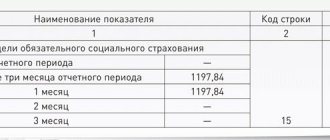Options for calculating average daily earnings
| Temporary disability benefits | Benefits for pregnancy and childbirth, for child care up to 1.5 years | Vacation pay and compensation for unused vacation | Other payments: for the duration of a business trip, for days of donating blood, days off to care for a disabled child, etc. | ||
| Regulations | Federal Law of December 29, 2006 No. 255-FZ, Decree of the Government of the Russian Federation of June 15, 2007 No. 375 | Art. 139 of the Labor Code of the Russian Federation, Decree of the Government of the Russian Federation No. 922 of December 24, 2007 | |||
| How is it counted? | Earnings for 2 years are divided by 730 | Earnings for 2 years are divided by the number of calendar days minus the days of excluded periods | Earnings for 12 months are divided by the average monthly number of calendar days in this period (for 1 full month - 29.3) | Earnings for 12 months are divided by the number of days actually worked in this period | |
| Saved for | All calendar days of the period of incapacity for work | All calendar days of maternity leave, parental leave up to 1.5 years (40%) | Calendar days of vacation, except for the official holidays listed in Art. 112 Labor Code of the Russian Federation | Working days according to the employee's schedule | |
| Payments involved in the calculation | All payments for which insurance contributions to the Social Insurance Fund are calculated | Payments within the framework of the employment relationship, except for payments for excluded periods (see below) | |||
| Payments not included in the calculation | Payments for which contributions to the Social Insurance Fund were not accrued | All payments for excluded periods (see below) | |||
| Excluded periods | — | Periods of incapacity for work, maternity and child care leave | All periods during which the employee did not work, with the same average earnings or without payment, in accordance with the legislation of the Russian Federation (periods of incapacity for work, vacations, business trips, etc.) | ||
In what cases is the average earnings for benefits divided by 730, and in what cases by the actual number of calendar days in two years?
When calculating temporary disability benefits, earnings for two years are always divided by 730 days, regardless of whether a leap year is included in the calculation.
When calculating benefits for employment and childcare up to 1.5 years, earnings for two years are divided by the number of calendar days, minus excluded periods. That is, if a leap year falls within the calculation period, and there were no excluded periods, then the figure may be 731 or even 732 (if two leap years are taken for the calculation).
But in two cases the number 730 is still used for these benefits:
- when calculating minimum wage benefits;
- when calculating the maximum average daily earnings limit.
Accounting, payroll and reporting in a friendly service.
Try it for free
How and why the official average salary is calculated
The main source of statistical information in Russia is the Federal State Statistics Service, or simply Rosstat . The department’s website regularly publishes statistical data relating to various spheres of life in the country.
Most of all, society is interested in social indicators - the standard of living of the population, processes in the sphere of labor and employment, and price dynamics. One of the most important indicators that Rosstat calculates and publishes is data on the average salary in the country.
Rosstat has several sources of information. First of all, these are statistical reports submitted by organizations and entrepreneurs, data from the Federal Tax Service (FTS) and the Pension Fund of Russia (PFR). The second source is survey data.
Information from official reports and federal authorities is accurate, but for obvious reasons it only takes into account the “open” part of the economy. While several million Russians work “in the shadows” and data on their income can only be obtained from surveys.
To determine the official average monthly salary, Rosstat takes into account the total wage fund divided by the number of personnel of enterprises and organizations. Data is displayed before personal income tax is paid.
In order to understand the entire situation on the labor market, Rosstat calculates several values of the average monthly salary :
- for the country as a whole;
- for individual subjects of the Russian Federation;
- for different sectors of the economy;
- by specialty of employees;
- by educational level of workers.
In addition, the average monthly salary can be calculated both for individual months and for the whole year .
When calculating the average monthly salary, Rosstat takes into account all payments that an employee officially receives - these are wages for full and part-time working days/weeks/months, various additional payments to wages, one-time and compensation payments.
The average monthly salary data calculated by Rosstat is an official figure and is used in some calculations .
The main one is the calculation of alimony in accordance with the Family Code.
However, the average monthly salary is also taken into account in other calculations. For example, the so-called “May Decrees” of the Russian President in 2012 established the ratio of salaries of public sector employees with average salaries in the industry and region:
- the salaries of school teaching staff should have been brought up to the average salary in the region;
- salaries of teachers in preschool education – up to the average salary in the general education sector;
- salaries of teachers and masters in the field of vocational education – up to the average salaries in the region;
- the salaries of doctors , university teachers and scientists were supposed to be twice as high as the average salaries in the region;
- salaries of social workers , junior and paramedical personnel - up to the average salary in the region.
As statistics show, not all of these decrees were actually implemented, and even if they were implemented, it was mostly formally (for example, by transferring junior medical personnel to the category of cleaners).
Finally, data on average salaries are taken into account when planning socio-economic development programs , when comparing the levels of development of individual regions of the country, as well as when comparing salaries in Russia and other countries.
Practical advice on calculating vacation pay
If there was a salary increase before or during the vacation...
If before the employee’s vacation or during the vacation, the enterprise had an increase in salaries (tariff rates) as a whole for the organization (division), it is necessary to index the average earnings to calculate vacation pay.
The procedure for increasing average earnings provides for three indexation options:
- The salary increased during the pay period. All payments taken into account when calculating vacation pay from the beginning of the billing period until the month of salary change are multiplied by the increase factor (Kpv). Kpv = He/Os, where He is the new salary, Os is the old salary.
- The salary increased after the pay period before the start of the vacation. The entire calculated average earnings are multiplied by the increase factor.
- Salary increased during vacation. Only part of the vacation pay increases, starting from the effective date of the new salaries.
Average income for a business trip
A business trip is the fulfillment of one’s work obligations, but outside the permanent workplace due to orders from management. The average salary indicator is also used to pay travel allowances. But in this case it is worth considering a number of points characteristic of payment for an on-site work process, namely:
- the main practice is to pay additional funds to the employee as a kind of moral compensation for the need to leave the city or country;
- working hours on a business trip are considered irregular;
- The geographic indicator of the employee’s departure is taken into account separately, since this may be an area that requires a surcharge coefficient, for example, the Far North region and others.
In such cases, the accountant makes accruals according to the following scheme:
- The employee’s daily wage is calculated and multiplied by the established bonus coefficient. For example, the additional reward is determined at 20%, then the coefficient should be taken at 1.2.
- the resulting figure must be multiplied by the locality coefficient, which is established at the state level. But this should only be done if the employee is actually sent to areas with additional pay.
- the calculation result is multiplied by the number of travel days, which are recorded on the arrival sheet. It is worth noting that in this case it is necessary to take into account both the day of arrival and departure, as well as weekends that fall during the business trip.
- The last step is to subtract the amount of income tax from the amount received.
This is a calculation of the amount that is an element of the average salary. Daily allowances, apartment allowances, and travel passes that were spent during a business trip are not taken into account when determining this indicator, since they are not income.
If an employee gets sick while on vacation...
If an employee has provided a certificate of incapacity for work (sick leave) for illness or injury, which was issued during vacation, it is necessary to calculate and pay temporary disability benefits. In this case, the vacation is extended by the number of days of sick leave or these days are transferred to another time.
When extending your vacation, it is not necessary to recalculate your average earnings; you can simply transfer the vacation days to the timesheet, the amount remains the same.
When transferring vacation, it is necessary to reverse the amount paid for vacation days falling during the sick leave period. If vacation is granted at another time, you will need to recalculate your average daily earnings based on a different calculation period.
Note . A certificate of incapacity for caring for a sick family member during vacation is not paid and does not give the right to extend or postpone the vacation.
Salary arrears
Rosstat announces an increase in the total wage debt in the Russian Federation. So, in February of this year this figure was 12 percent. The amount of debt should also include 40 percent for last year and 48.9 percent for the year before.
At the same time, wage debt as of November 1, 2020 was recorded to 43.1 thousand citizens. Including workers in the following industries:
- manufacturing industries – 46%;
- mining - 5%;
- hunting, agriculture and services related to these areas – 10%;
- construction – 18%;
- transport – 8%.
Quite legal tricks
In some cases, an employee may be able to “save” vacation days or earn slightly more vacation pay by taking days off at the beginning and end of the vacation period.
For example, an employee goes on vacation for three weeks from July 4 to July 24. In fact, he rests from July 2 to July 24 (July 2, 3, 23 and 24 are days off).
An employee can write an application from 2 to 24 (including weekends), or from 4 to 22. The rest time will be the same, but in the first case, vacation pay will be accrued for 23 days and there will be another 5 days of vacation (28 - 23) that can be used Later. In the second case, vacation pay will be accrued for 19 days, but there will still be 9 days of vacation left.
Both options do not contradict the law. Please note that at least one part of the vacation per year must be at least 14 days (in accordance with Article 125 of the Labor Code of the Russian Federation).
conclusions
It is not for nothing that Russian labor legislation is considered quite balanced and well-structured. The established legal norms sufficiently protect the interests of both the employer and the employee.
Another question is that often the latter simply do not know all their legal rights, which unscrupulous employers shamelessly take advantage of.
In any case, you don’t have to be an expert in labor relations to understand that all downtime that arose through no fault of the employee must be paid. And the labor code and articles on the Internet will help you find a link to a specific legal norm.







